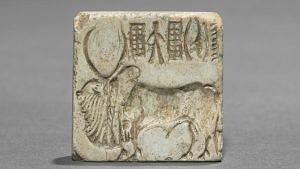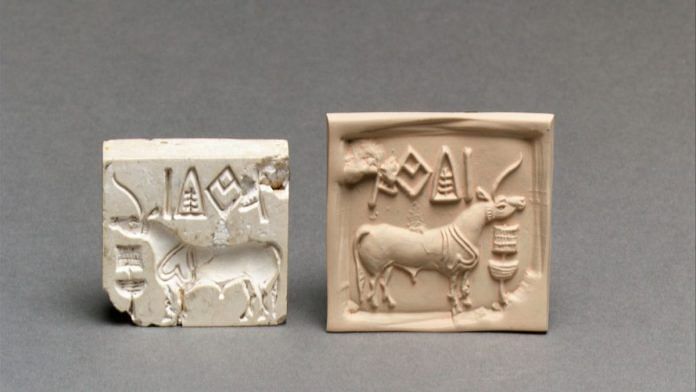Square or rectangular objects used for stamping that are typically made from steatite, featuring carvings on the front and a perforated boss on the back, stamp seals are one of the most extensively found cultural artifacts from the Indus Valley Civilisation. Numbering approximately two thousand, they were likely in use during its Mature Harappan Phase. They were excavated from many urban sites in the Indus Valley but were most prevalent in the Mohenjo-daro archaeological site in present-day Pakistan.
These seals are understood to have been used primarily in trade as a designatory device, and their discovery from sites beyond the known Indus Valley region — such as Kish and Umma, and in Iraq — is indicative of an early system of trade with other societies such as the Mesopotamian Civilisation of Western Asia, where both flat and cylindrical seals existed.
Typically, the front of the seal is carved in intaglio so that a positive imprint is produced on the material on which it is impressed. The back of the seal is in the form of a knob-like protrusion or boss, for easy handling, with a perforation that possibly allowed the stamp to be strung and worn as an amulet. Apart from the steatite, or soapstone seals, believed to have been given a surface glaze by treating with alkali and heating, rarer seals made of terracotta, silver and faience have also been recovered from Indus Valley sites.
Also read:
The symbolic and formal imagery on the seals are typical of Indus Valley iconography and consist of bovine figures such as bulls, water buffalo, Indian gaur or wild ox and zebu; other animals such as elephants, rhinoceroses, tigers; fantastical creatures such as unicorns (sometimes interpreted to be bovine animals in strict profile) and plants, although less common; and human and human-like figures. Seals also often carried illustrated scenes of people seemingly engaged in religious activities, accompanied by motifs such as the sacred fig, vessels and agricultural tools. The geometric forms and naturalistic figurations are almost always accompanied by inscriptions of four to seven characters in the as-yet-undeciphered Indus script, making the Indus Valley stamp seals the most dominant set of artefacts to feature it.

Although the exact use and the meaning of the seals cannot be confirmed, it is suggested that they could have been used as marks of identification, owing to the uniqueness of the inscriptions found on them. It has also been suggested that they were used in trade, to stamp clay insignia on ropes to seal and secure packages during transportation, ( the depiction of pack animals lending support to this interpretation), and by traders and merchants to designate their goods by name, place of origin and so on. A ritualistic function has also been ascribed to these seals due to renderings of thematically central human or humanoid figures of priests or deities, such as in the famous Pashupati seal, and of narrative scenes, as in the Seal of Divine Adoration.
The largest collection of Indus Valley stamp seals is housed in the National Museum, Delhi, while a significant number of them are in museums across Pakistan such as the Harappa Museum in the Punjab province and the Mohenjo-daro Museum in Sindh. Smaller collections of seals can be found in museums in the United States of America and the United Kingdom, including at the Metropolitan Museum of Art, New York and the British Museum, London.
This excerpt is taken from MAP Academy’s ‘Encyclopedia of Art’ with permission.
The MAP Academy is a non-profit, online platform — consisting of an Encyclopedia, Courses and a Blog — which encourages knowledge building and engagement with the visual arts of the region.



